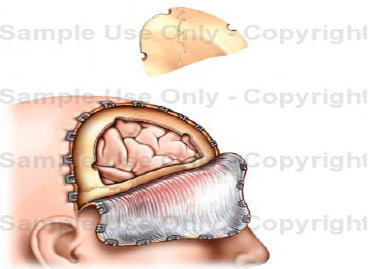What is a craniotomy & resection of intrinsic lesion?
A Craniotomy and resection of Intrinsic Lesion is performed to remove a lesion from within the brain.
A cut is made over the area of the lesion. A segment of bone will be removed. The firm outside lining of the brain will be opened.
If the lesion is not seen on the surface of the brain, a cut is made into the brain to expose the lesion. A computerised guidance system is used to locate the exact location of the lesion.
The lesion is removed either from the inside by removing it piece by piece or by going around the outside of the lesion to separate it from the brain.
As much of the lesion will be removed as is safe to do so. The skull bone is put back and is closed with plates and screws and the cut closed with stitches or staples.
My Anaesthetic
This procedure will require a General Anaesthetic.
See About your Anaesthetic information sheet for information about the anaesthetic and the risks involved. If you have any concerns, talk these over with your doctor.
If you have not been given an information sheet, please ask for one.
What are the risks of this specific procedure?
There are some risks/complications with this procedure.
Common risks include:
- Infection. This may need antibiotics and further treatment.
- IV cannula. This may cause minor pain, bruising and/or infection at the injection site. This may require treatment with antibiotics.
- Bleeding. If bleeding occurs further surgery may be required. Bleeding is more common if you have been taking blood thinning drugs such as Warfarin, Asprin, Clopidogrel (Plavix or Iscover) or Dipyridamole (Persantin or Asasantin)
Bleeding may require a blood transfusion and further surgery.
- Small areas of the lung may collapse, increasing the risk of chest infection. This may need antibiotics and physiotherapy.
- Increase risk in obese people of wound infection, chest infection, heart and lung complications, and thrombosis.
- Clots in the leg (deep vein thrombosis or DVT) with pain and swelling. Rarely part of this clot may break off and go into the lungs.
- A heart attack because of the strain on the heart.
- Stroke like complications which can cause weakness in the face, arms and/or legs. This may be temporary or permanent.
- Injury to the brain, important nerves or blood vessels. This can lead to memory disturbance.
- Fluid leakage from the brain can occur after the operation. This may require further surgery.
- Epilepsy which may require medication. This condition may be temporary or permanent.
- Loss of vision which may be temporary or permanent.
- The lesion may not be cured by surgery and may require further treatment such as radiotherapy.
- It is likely that not every cell of the intrinsic lesion will be able to be removed. This may require further treatment.
- Coma.
- Death is possible due to this procedure.


 Appointments
Appointments